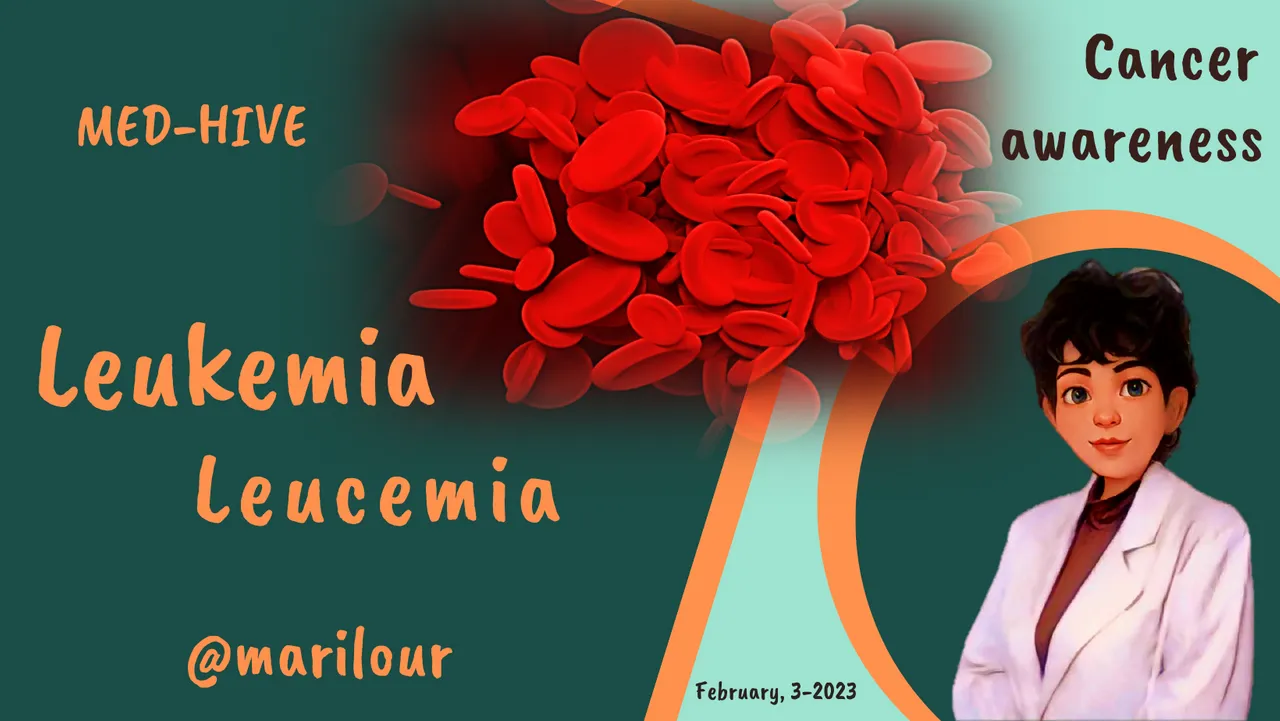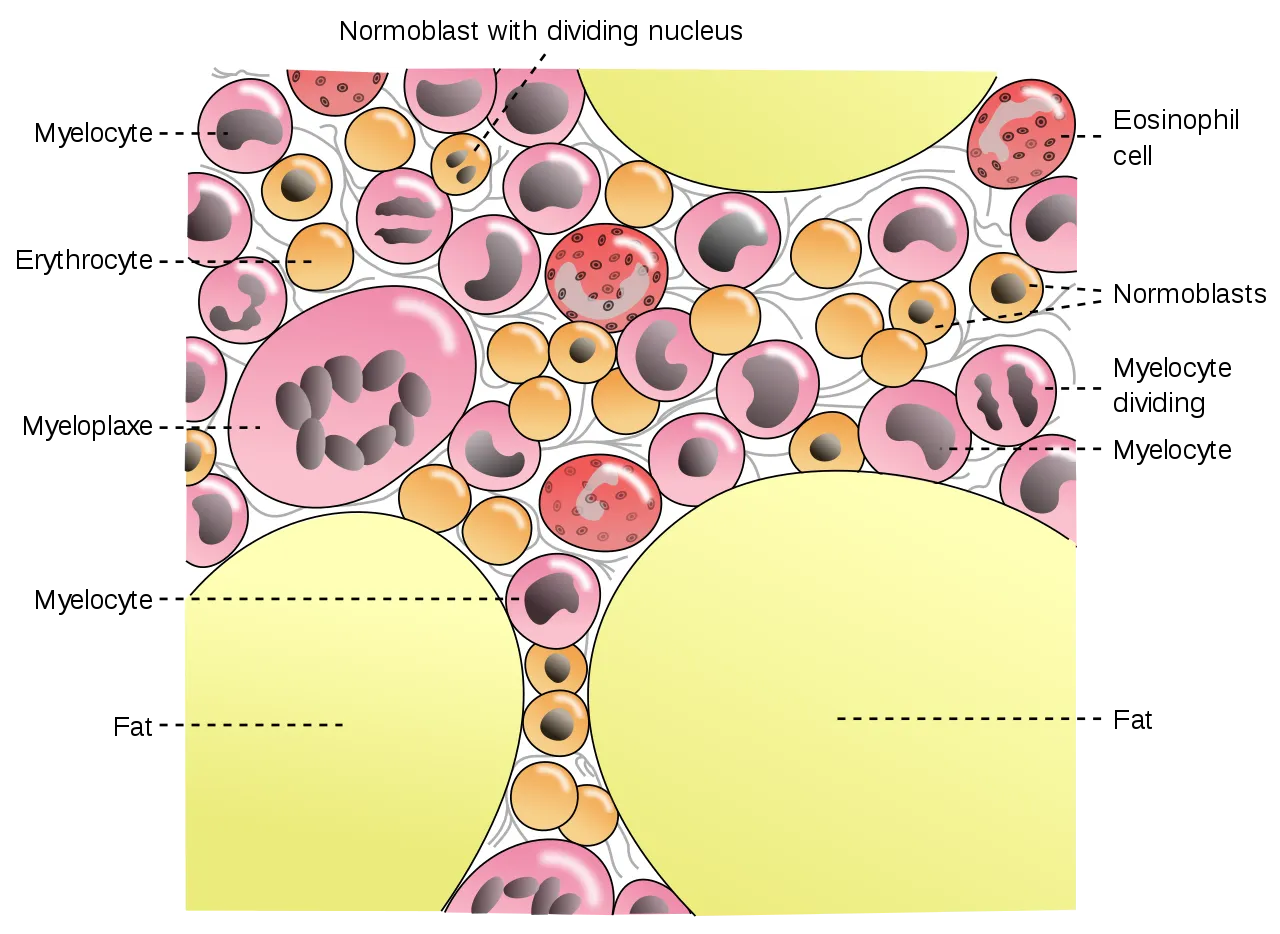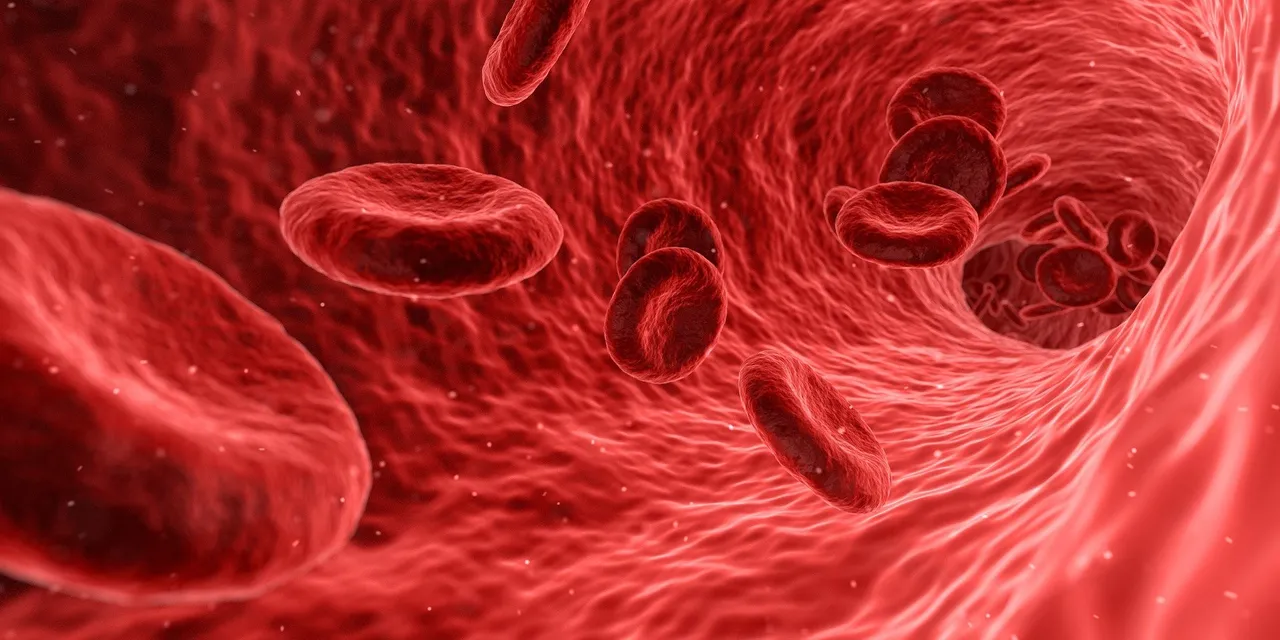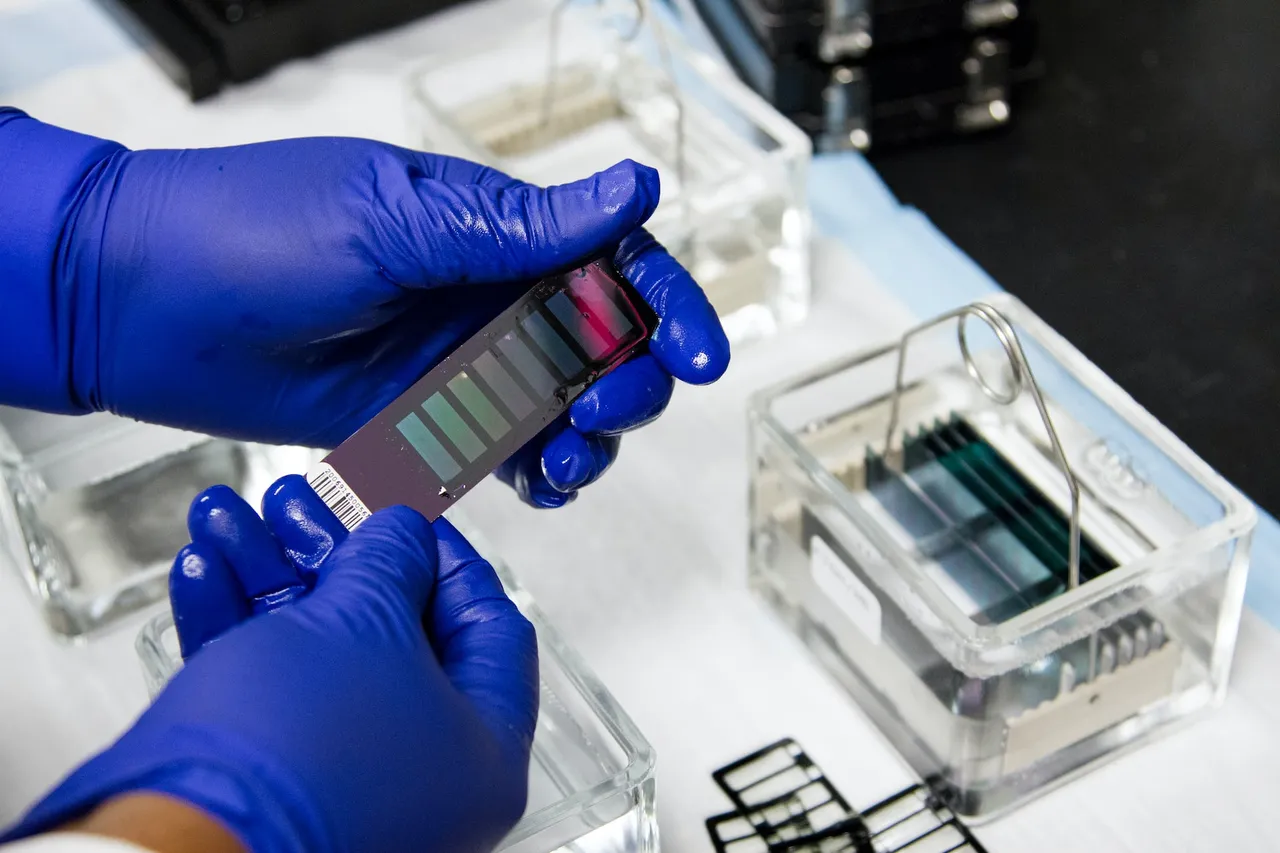
Greetings, friends of Hive
We join this call, expressing that the term cancer, encompasses a large group of diseases, which have as a common characteristic, the accelerated multiplication of cells without control and autonomously; colonizing and invading tissues, organs, devices and systems, anywhere in the body.
This meeting will deal with a type of blood cancer, in which different types of blood cells are affected, it is leukemia. But before the inherent aspects of the disease, let us deal with the basic contextualizations of morphology. Let us begin.
Bone marrow

Crédit: Mysid. Public domain.
Bone marrow is a tissue found in the bones. It is composed of stem cells (multipotent cells capable of becoming different cell types), fat cells and blood cells at different stages of maturation. Blood passes through the bone marrow, collecting red blood cells, white blood cells and platelets, which are developed and functional, to circulate throughout the body.
The Blood

Source
It is the liquid that runs through our body, it represents the main transport system of oxygen and nutrients; as well as the transport of waste products, which must be eliminated.
It is composed of 80% plasma and 20% cellular structures:
- Plasma, a yellowish liquid containing water, salts, sugars and proteins; it provides nutrients to the cells and strengthens the immune system.
- Red blood cells (erythrocytes) carry oxygen.
- White blood cells (leukocytes) represent the defense system. There are several types, among which we can mention neutrophils, basophils, eosinophils, monocytes and lymphocytes.
- Platelets (thrombocytes) are involved in blood clotting processes.
Leukemia

Crédit: Ayman Qasrawi. Public domain.
What are leukemias?
Etymologically, the word leukemia derives from the Greek words "leukos", meaning white, and "haima", meaning blood. It is a general term used to refer to various types of blood cancer. It encompasses malignant neoplasms, with an excess of white blood cells, a condition that is evident in patients with these diseases.
Leukemia begins when a bone marrow cell undergoes an abnormal change and becomes a type of leukemic (cancerous) cell. These pathological (diseased) cells multiply and survive better than normal cells. Over time, the diseased (cancerous) cells displace and/or inhibit the development of the normal cells, thus spreading the disease.
Leukemic cells, on the other hand, can invade organs such as the spleen, liver or lymph nodes and condition the growth of the affected organ.
Classification

Source
Leukemias are classified according to cellular origin (affected cell) and evolution (speed of progression).
- According to cellular origin:
-Myeloid leukemia, the abnormal change begins in the myeloid cells.
-Lymphoid leukemia, the abnormal change begins in the lymphoid cells. - According to evolution:
-Acute leukemia, starts accelerated and the number of leukemic (diseased) cells multiplies and increases rapidly.
-Chronic leukemia, with slow evolution and better tolerance.
Signs and symptoms
These are the manifestations and expressions of our body, and most likely indicate the presence of the disease. The signs and symptoms of leukemia can be very unspecific and not very orientative.
The adjacent image summarizes the main and most frequent ones, I invite you to familiarize yourself with them and to take them into account.

Crédit: Mikael Häggström. Public domain.
If you have signs and symptoms that do not disappear or worsen, you should consult a doctor as soon as possible to find out what the cause is. If the cause is not cancer, a doctor can help determine the cause and treat it, if necessary.
Diagnosis

Diagnosis is intended to be a thorough assessment of the situation. It is based on tests and laboratory studies. It involves analyzing how the different blood cells (red blood cells, white blood cells and platelets) are in shape and quantity. Also coagulation tests and biochemical studies to determine the functioning of the liver, spleen and kidneys. Also, bone marrow studies, to study the cellular composition.
Imaging studies such as X-rays, ultrasound, tomography
or magnetic resonance and any other studies necessary for the patient are sometimes indicated.
Treatment

Source
In leukemia, the fundamental objective of treatment is to achieve that there are no signs of disease, that the patient recovers his or her state of good health. Therapies are diverse and are individualized in each situation, and may include chemotherapy, radiotherapy, bone marrow transplantation, immunotherapy, clinical trials (new oncological treatments), nutritional care, psychological support,
among others.
Can leukemia be prevented?
Factors that could generate an increased risk of developing leukemia have been mentioned: exposure to benzene, ionizing radiation, electromagnetic radiation, hair dyes, among others. However, to date there is no conclusive evidence, but we should be cautious.
We can prevent leukemia by taking care of our physical state, controlling our emotions, in balance with our spiritual state. Assuming and adopting healthy habits, such as weight control, balanced diet, physical activity, little alcohol and no smoking.
In tune, practice self-care, paying close attention to the signals emitted by the body, as warning messages.
Go regularly to your health controls, with specialized assessment and periodic diagnostic tests, only in this way there will be an early detection of cancer.

Source

Español
Saludos, amigos de Hive
Nos unimos a esta convocatoria, expresando que el término cáncer, incluye un gran grupo de enfermedades, que tienen como característica común, la multiplicación acelerada de células sin control y de forma autónoma; colonizando e invadiendo tejidos, órganos, aparatos y sistemas, en cualquier parte del cuerpo.
Este encuentro tratará sobre un tipo de cáncer de la sangre, en el que se ven afectados diferentes tipos de células sanguíneas, se trata de la leucemia. Pero antes de los aspectos inherentes a la enfermedad, tratemos contextualizaciones básicas de la morfología. Comencemos.
Médula ósea

Crédito: Mysid y Basquetteur. Usado bajo licencia CC0 1.0.
La médula ósea es un tejido que se encuentra en los huesos. Se compone de células madre (células multipotenciales capaces de convertirse en diferentes tipos celulares), células grasas y células sanguíneas en diferentes etapas de maduración. La sangre pasa a través de la médula ósea, recogiendo los glóbulos rojos, glóbulos blancos y plaquetas, que están desarrollados y son funcionales, para circular por todo el cuerpo.
La sangre

Fuente
Es el líquido que recorre nuestro cuerpo, representa el principal sistema de transporte de oxígeno y nutrientes; así como el transporte de productos de desecho, que deben ser eliminados. Este tejido está compuesto por un 80% de plasma y 20% de estructuras celulares:
- El plasma es un líquido amarillento que contiene agua, sales, azúcares y proteínas; aporta nutrientes a las células y refuerza el sistema inmunitario.
- Los glóbulos rojos (eritrocitos), transportan oxígeno.
- Los glóbulos blancos (leucocitos), representan el sistema de defensa. Hay varios tipos, entre los que podemos mencionar neutrófilos, basófilos, eosinófilos, monocitos y linfocitos.
- Las Plaquetas (trombocitos), intervienen en los procesos de coagulación de la sangre.
Leucemia

Crédito: Ayman Qasrawi. Dominio público.
¿Qué son las leucemias?
Etimológicamente, el vocablo leucemia, deriva de las palabras griegas 'leukos', que significa blanco, y 'haima, que significa sangre. Es un término general, utilizado para referirse a varios tipos de cáncer en la sangre. Incluye las neoplasias malignas, con un exceso de glóbulos blancos, condición que se pone de manifiesto en los pacientes con estas enfermedades.
La leucemia comienza, cuando una célula de la médula ósea, sufre un cambio anormal y se convierte en un tipo de célula leucémica (cancerosa). Estas células patológicas (enfermas) se multiplican y sobreviven mejor que las células normales. Con el tiempo, las células enfermas (cancerosas) desplazan y/o inhiben el desarrollo de las células normales, propagando así la enfermedad.
Las células leucémicas, por su parte, pueden invadir órganos como el bazo, el hígado o los ganglios linfáticos y condicionar el crecimiento del órgano afectado.
Clasificación

Fuente
Las leucemias se clasifican considerando el origen celular (célula afectada) y la evolución (velocidad de progresión).
- Según el origen celular:
-Leucemia mieloide, el cambio anormal comienza en las células mieloides.
-Leucemia linfoide, el cambio anormal comienza en las células linfoides. - Según la evolución:
-Leucemia aguda, se inicia aceleradamente y el número de células leucémicas (enfermas) se multiplican y aumentan rápidamente.
-Leucemia crónica, es de evolución lenta y mejor tolerancia.
Signos y síntomas
Son las manifestaciones y expresiones de nuestro cuerpo, y lo más probable es que indiquen la presencia de enfermedad. Los signos y síntomas de la leucemia, pueden ser muy inespecíficos y poco orientativos.
La imagen adyacente resumen los principales y más frecuentes, te invito a familiarizarte con ellos y a tenerlos en cuenta.

Crédito: Techso01. Usado bajo licencia CC 4.0.
Si tiene signos y síntomas que no desaparecen o empeoran, debe consultar a un médico, lo antes posible para averiguar cuál es la causa. Si el cáncer no es la causa, un médico puede ayudar a determinar la causa y tratarla, si es necesario.
Diagnóstico

Fuente
El diagnóstico pretende, ser una evaluación exhaustiva de la situación. Se basa en pruebas y estudios de laboratorio. Consiste en analizar la forma y la cantidad de las distintas células sanguíneas (glóbulos rojos, glóbulos blancos y plaquetas). También pruebas de coagulación y estudios bioquímicos para determinar el funcionamiento del hígado, el bazo y los riñones. Así mismo, estudios de médula ósea, para estudiar la composición celular.
En ocasiones están indicados estudios de imagen como radiografías, ecografías, tomografías o resonancias magnéticas y cualquier otro estudio necesario para el paciente.
Tratamiento

Fuente
En la leucemia, el objetivo fundamental del tratamiento es conseguir que no haya signos de enfermedad, que el paciente recupere su estado de buena salud. Las terapias son diversas y se individualizan en cada situación, pueden incluir quimioterapia, radioterapia, trasplante de médula ósea, inmunoterapia, ensayos clínicos (nuevos tratamientos oncológicos), cuidados nutricionales, apoyo psicológico, entre otros.
¿Se puede prevenir la leucemia?
Se han mencionado factores que podrían generar un mayor riesgo de desarrollar leucemia: exposición al benceno, radiaciones ionizantes, radiaciones electromagnéticas, tintes para el cabello, entre otros. Sin embargo, a la fecha no hay pruebas concluyentes, pero debemos ser precavidos.
Podemos prevenir la leucemia, cuidando nuestro estado físico, controlando las emociones, en equilibrio con nuestro estado espiritual. Asumiendo y adoptando hábitos saludables, como el control del peso, dieta balanceada, actividad física, poco alcohol y nada de tabaco.
En sintonía, practicar el autocuidado, prestando mucha atención a las señales que emite el cuerpo, como mensajes de alerta.
Acude regularmente a tus controles de salud, con valoración especializada y pruebas diagnósticas periódicas, solo así habrá una detección precoz del cáncer.

Fuente
Bibliographic references consulted / Referencias bibliográficas consultadas
-American Cancer Society. Signs and symptoms of cancer [Internet]. 2020. [quoted 2023 Feb.] Available at
-Costello, B. Blood. Texas Heart Institute. [Internet]. 2023 [quoted 2023 Feb.] Available at-Davis A.S., Viera A.J., Mead M.D. Leukemia: An overview for primary care. Am Fam Physician. [Internet]. 2014. [quoted 2023 Feb.] 89(9):731-738. Available at
-Leukemia & Lymphoma Society (LLS). Información sobre el cáncer de la sangre. [Internet] [quoted 2023 Feb]. Available at
-Leukemia & Lymphoma Society (LLS). Información sobre los tipos de cáncer de la sangre. [Internet] [quoted 2023 Feb]. Available at -Whiteley A.E., Price T.T., Cantelli G., Sipkins D.A. Leukaemia: a model metastatic disease. Nat Rev Cancer.[Internet]. 2021. [quoted 2023 Feb.] 21(7): 461–475. Available at
Sobre mí Soy venezolana. PhD. Médico Parasitólogo-Protozoólogo. Formada en Salud Colectiva, Ciencias Médicas Fundamentales, Filosofía de la Ciencia y Gestión Educativa.
Sobre la portada: es una producción original realizada con el programa Canva (versión gratuita), utilizando elementos libres de regalías. El avatar es producto de una fotografía de mi propiedad, procesada con la aplicación Toonlab. En la portada se incluyó una imagen esta es la fuente.La producción escrita ha sido creada esclusivamente para esta participación.
